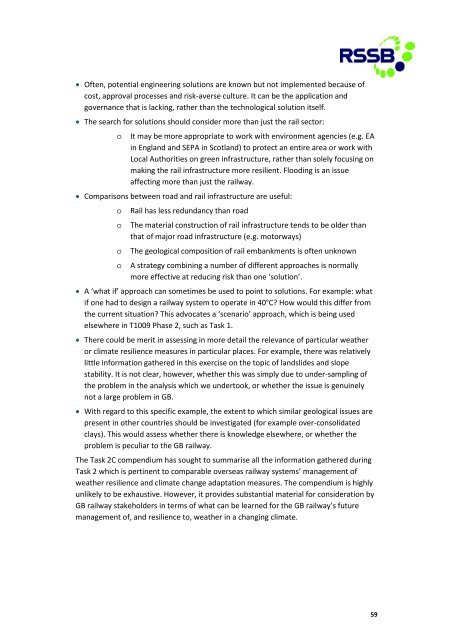Tomorrow's Railway and Climate Change Adaptation Final Report
2016-05-T1009-final-report
2016-05-T1009-final-report
You also want an ePaper? Increase the reach of your titles
YUMPU automatically turns print PDFs into web optimized ePapers that Google loves.
• Often, potential engineering solutions are known but not implemented because of<br />
cost, approval processes <strong>and</strong> risk-averse culture. It can be the application <strong>and</strong><br />
governance that is lacking, rather than the technological solution itself.<br />
• The search for solutions should consider more than just the rail sector:<br />
o<br />
It may be more appropriate to work with environment agencies (e.g. EA<br />
in Engl<strong>and</strong> <strong>and</strong> SEPA in Scotl<strong>and</strong>) to protect an entire area or work with<br />
Local Authorities on green infrastructure, rather than solely focusing on<br />
making the rail infrastructure more resilient. Flooding is an issue<br />
affecting more than just the railway.<br />
• Comparisons between road <strong>and</strong> rail infrastructure are useful:<br />
o<br />
o<br />
o<br />
o<br />
Rail has less redundancy than road<br />
The material construction of rail infrastructure tends to be older than<br />
that of major road infrastructure (e.g. motorways)<br />
The geological composition of rail embankments is often unknown<br />
A strategy combining a number of different approaches is normally<br />
more effective at reducing risk than one ‘solution’.<br />
• A ‘what if’ approach can sometimes be used to point to solutions. For example: what<br />
if one had to design a railway system to operate in 40°C? How would this differ from<br />
the current situation? This advocates a ‘scenario’ approach, which is being used<br />
elsewhere in T1009 Phase 2, such as Task 1.<br />
• There could be merit in assessing in more detail the relevance of particular weather<br />
or climate resilience measures in particular places. For example, there was relatively<br />
little information gathered in this exercise on the topic of l<strong>and</strong>slides <strong>and</strong> slope<br />
stability. It is not clear, however, whether this was simply due to under-sampling of<br />
the problem in the analysis which we undertook, or whether the issue is genuinely<br />
not a large problem in GB.<br />
• With regard to this specific example, the extent to which similar geological issues are<br />
present in other countries should be investigated (for example over-consolidated<br />
clays). This would assess whether there is knowledge elsewhere, or whether the<br />
problem is peculiar to the GB railway.<br />
The Task 2C compendium has sought to summarise all the information gathered during<br />
Task 2 which is pertinent to comparable overseas railway systems’ management of<br />
weather resilience <strong>and</strong> climate change adaptation measures. The compendium is highly<br />
unlikely to be exhaustive. However, it provides substantial material for consideration by<br />
GB railway stakeholders in terms of what can be learned for the GB railway’s future<br />
management of, <strong>and</strong> resilience to, weather in a changing climate.<br />
59


